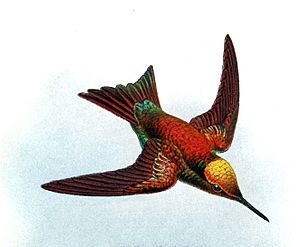Green-tailed emerald facts for kids
Quick facts for kids Green-tailed emerald |
|
|---|---|
 |
|
| Chlorostilbon alice micans painted by John Gerrard Keulemans | |
| Scientific classification | |
| Genus: |
Chlorostilbon
|
| Species: |
alice
|
 |
|
| Synonyms | |
|
Chlorostilbon poortmani alice |
|
The green-tailed emerald (Chlorostilbon alice) is a beautiful type of hummingbird. It belongs to a group of hummingbirds called "emeralds." This tiny bird lives only in Venezuela, a country in South America.
Contents
Understanding the Green-tailed Emerald's Family Tree
Scientists group living things into categories. This helps us understand how different animals are related. The green-tailed emerald was first called Trochilus alice. Later, it was moved to its current group, Chlorostilbon.
Most bird experts agree that the green-tailed emerald is its own unique species. However, some think it might be a subspecies of another hummingbird, the short-tailed emerald.
What Does the Green-tailed Emerald Look Like?
These hummingbirds are quite small! Male green-tailed emeralds are about 7.5 to 8.5 cm (3 to 3.3 inches) long. Females are a bit smaller, at 6.5 to 7.5 cm (2.6 to 3 inches). They weigh only about 3 to 4 grams (0.11 to 0.14 ounces). That's lighter than a few paper clips!
Both male and female birds have a short, straight, black beak. The male has a shiny dark green head and a bronze-green back. His tail is also a glittering bronze-green, and his belly is bright grass green.
Female green-tailed emeralds have a similar back to the males. They have a white stripe behind their eye. Their belly is a pale grayish color. The feathers under their tail are dark gray. Their middle tail feathers are green, while the others have green bases with black tips. Young birds look a lot like the females.
Where the Green-tailed Emerald Lives
The green-tailed emerald is found only in northern Venezuela. You can find it from the state of Falcón in the west, south to Lara and Sucre, and east to Monagas.
This hummingbird likes to live on the edges of different types of forests. These include humid rainforests, cloudforests, and even forests that have grown back after being cut down. They also live in plantations and sometimes in dry forests. You can find them at elevations between 700 and 1800 meters (2,300 to 5,900 feet) above sea level.
How the Green-tailed Emerald Behaves
Bird Movements
Scientists are still learning about how the green-tailed emerald moves around. It doesn't fly long distances like some other birds. Instead, it makes smaller, irregular trips between different places and elevations.
What the Green-tailed Emerald Eats
The green-tailed emerald eats nectar from flowers. It has clever ways of finding food. Sometimes it flies a regular route to visit flowers that don't have a lot of nectar. Other times, it "steals" nectar from richer flowers in other hummingbirds' territories! Male birds might even defend areas with lots of nectar.
This hummingbird usually looks for food fairly low to the ground, often between 1 and 6 meters (3 to 20 feet) high. It gets nectar from many different kinds of flowering plants and shrubs. Besides nectar, it also eats small insects. It catches these insects by flying out from a perch, like a small branch.
Reproduction and Life Cycle
The green-tailed emerald's breeding season is from January to March. The female builds a cup-shaped nest using plant fibers, small pieces of leaves, and bark. She lines the inside with soft materials and covers the outside with leaf pieces and twigs.
The nest is usually placed on a thin branch, about 1 meter (3 feet) above the ground. The female lays two eggs and keeps them warm for about 14 days. The young birds are ready to leave the nest about 20 to 22 days after they hatch.
Green-tailed Emerald Sounds
There aren't many recordings or descriptions of the green-tailed emerald's song. However, it does make a "soft chittering" sound while it is looking for food.
Green-tailed Emerald Status
The green-tailed emerald is not listed separately by some conservation groups. This is because they consider it part of the more common short-tailed emerald species. Even though it lives in a specific area, it is considered common in those places. This bird also seems to do well in places changed by humans, like plantations, parks, gardens, and roadsides.
See also
 In Spanish: Chlorostilbon alice para niños
In Spanish: Chlorostilbon alice para niños

